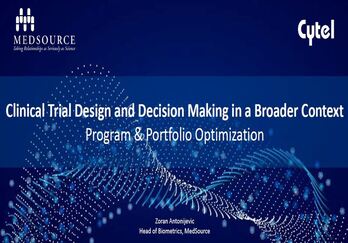Program and Portfolio Optimization: A New Paradigm

Significant advances have been made to enhance the efficiency of clinical trial designs. However, the traditional methods deployed by many pharmaceutical companies are fraught with challenges. Much less consideration is given to the value of decisions in the context of development programs or portfolios.
Cytel recently launched the “C-Suite Webinar Series”, an online initiative to help pharmaceutical executives drive commercial success with strategic insight from statistics. As a part of this series, Zoran Antonijevic, Head of Biometrics at MedSource, conducted a webinar where he describes methods for maximizing the value of programs and portfolios. This event was attended by numerous biopharma leaders.
Continue reading this blog to understand the concepts of program and portfolio optimization and learn about the benefits and opportunities presented by them.
Driving Commercial Success through Program Optimization
The objective of program level decision making is to recognize that each clinical trial is part of a larger program for drug discovery. Phase 3 studies are extremely expensive and hence, it is important to take a strategic approach to clinical development in order to minimize the potential for Phase 3 attrition. The goal of Program Level Optimization is to model Phase 2 and Phase 3 trials as components in a program, and to be sure to gather enough information in Phase 2 to make better decisions about launching and designing confirmatory Phase 3 trials. In Phase 2, finding more effective dose and/or subpopulation leads to higher success rates in Phase 3 and an improved efficacy and safety profile. For example, an extensive simulation study with 112 different Phase 2 design scenarios showed almost two-fold improvement in risk adjusted net present value (raNPV) between worst and best scenario.
Facilitating Improvements through Portfolio Optimization
The goal of portfolio level optimization is to improve the allocation of a fixed budget into individual trials, which in turn leads to an improved value of the portfolio. The expected Net Present Value is no longer the best measurement in such a case and a much better outcome that we should be focusing on, at a Portfolio level, is Return on Investment (ROI), best defined as raNPV/budget spent.
How to Optimize at the Portfolio Level?
- A straightforward approach for portfolio optimization used by several companies is Program Prioritization. The objective is to order programs by profitability index and fit as many as you can within your budget. This can result in 40-50% improvement in value over portfolios that are not optimized.
- True optimization can allow you to adjust parameters (sample size, number of doses, enriched population etc.) within individual programs that provide optimal portfolio solution. Trial simulations can provide an additional 10-15% improvement over Program Prioritization. This approach requires more flexibility in designs and should involve innovative designs and clinical trial optimization.
Problem with not Optimizing at the Portfolio Level
For any given program, if you increase the sample size, you increase both Type I Error and Type II Error. Whereas, Type III Error (Beckman, Chen) that applies to portfolio only, is defined as the missed opportunity to invest into trials that might have identified good treatments, and its impact on portfolios can be huge. This makes portfolio optimization very important as it allows companies to make investments in such ways that revenues are maximized.
Master Protocols – “Sub-Portfolios”
Master protocols are trending currently and are soon going to become the main approach in drug development, as several companies are incorporating them. They can be treated as sub-portfolios as they are protocols in which multiple treatments, diseases, patient subtypes, or combination of the previous are evaluated in one single overarching trial. Use of master protocols brings in operational and statistical efficiencies in drug development. Moreover, Protocols continue even after drug candidates exit, i.e. new trials need not be started each time. Standardization is implemented at the platform level and the biggest advantage is that decisions can be made in a broader context.
How to implement Program and Portfolio Level Optimization?
The implementation of the Program and Portfolio Level fits well into Pharmaceutical Frameworks. It is critical to first define the context, framework within which one can develop and assess alternatives, and appropriate outcomes. There are some important parameters of these frameworks, one is to distinguish between perceived risk and objective risk. In these frameworks, we aim to be objective and find if something new is better than what we are familiar with. We also need to develop options and quantify them to demonstrate if one is better than the others. For this we need to first define the context and the problem.
Additionally, we also need to take advantage of Bayesian methods when designing every Phase of a trial as well as in informing intra-trial decisions.
For an illustration of frameworks necessary for implementation of decisions at a higher level, watch the on demand webinar.
About Zoran Antonijevic
 Zoran Antonijevic is Head of Biometrics at MedSource. He held executive positions in Pharmaceutical Companies and CROs and has designed more than 100 clinical trials in numerous therapeutic areas, many of which included adaptive designs. Zoran is a long-time Chair and leader of the DIA Adaptive Design Scientific Working Group. He has authored numerous papers and scientific presentations and was editor of books “Optimization of Pharmaceutical R&D Programs and Portfolios” and “Platform Trials in Drug Development”.
Zoran Antonijevic is Head of Biometrics at MedSource. He held executive positions in Pharmaceutical Companies and CROs and has designed more than 100 clinical trials in numerous therapeutic areas, many of which included adaptive designs. Zoran is a long-time Chair and leader of the DIA Adaptive Design Scientific Working Group. He has authored numerous papers and scientific presentations and was editor of books “Optimization of Pharmaceutical R&D Programs and Portfolios” and “Platform Trials in Drug Development”.


